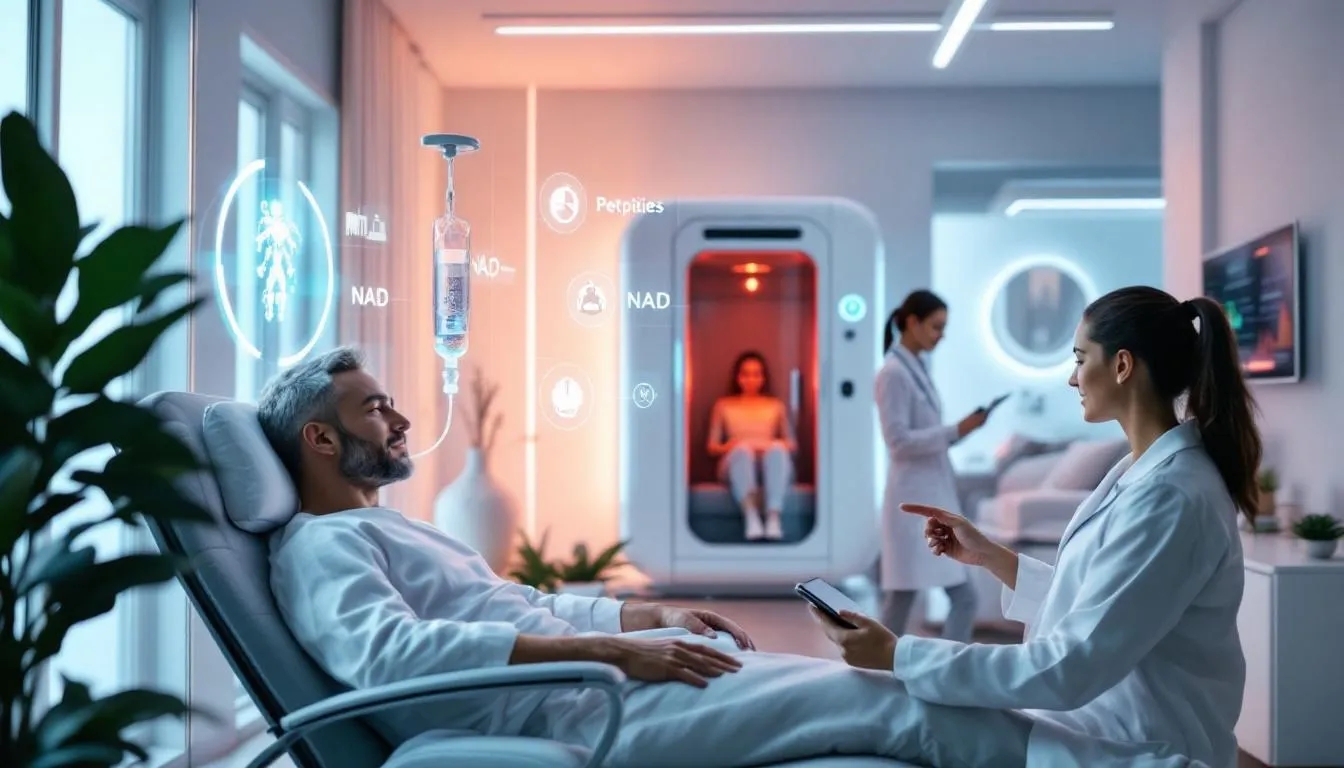Blog
Biohacking 101: Top 10 Wellness Therapies for Beginners (IV Drips, Peptides & More)

Biohacking is a collection of straightforward techniques designed to enhance how you feel and function. Think of it as a personal approach to optimizing your body and mind.
The trend has gained popularity among people seeking more energy, quicker recovery, and sharper focus. Biohacking does not require surgery or risky experiments.
Instead, it offers various therapies ranging from IV infusions and peptides to red light therapy and deep breathing. It’s important to start cautiously, research each method, and consult your doctor.
Begin slowly and pay attention to how your body responds.
1. IV Vitamin Therapy
IV vitamin drips deliver nutrients directly into your bloodstream. Some people claim these drips boost energy and immunity, but research is mixed.
A Mayo Clinic article notes that evidence for IV vitamin therapy in healthy people is limited and that diet, exercise, and sleep are more important. The article also points out that claims of benefits often rely on small or poorly designed studies.
IV therapy carries risks such as infection or bruising, so consult a medical professional.
2. Peptide Therapy
Peptides are short chains of amino acids. They act like signals to tell your body what to do. Some peptides support muscle growth, healing, and fat loss.
WebMD notes that peptide therapy is generally safe when supervised by a doctor. It warns that over‑the‑counter peptide supplements are untested by the FDA and may cause allergic reactions, heart palpitations, or digestive problems.
Always buy from a trusted provider and follow medical advice.
3. Hormone Balancing
Hormone levels can change with age and stress. Low testosterone, high cortisol, or thyroid imbalances can lead to fatigue, mood swings, and weight gain.
A full hormone panel checks levels of testosterone, estrogen, progesterone, thyroid hormones, and stress hormones. Testing helps you decide if natural changes (sleep, diet, stress reduction) are enough or if hormone therapy is needed.
For women, thyroid and reproductive hormones change through perimenopause; men often see a gradual drop in testosterone.
4. Intermittent Fasting
Intermittent fasting (IF) involves cycling between periods of eating and not eating. An NCBI review reports that IF can improve weight control, glucose homeostasis, and lipid profiles and may have anti‑inflammatory effects.
However, some studies showed a reduction in bone density and lean body mass, so combining IF with resistance training and a protein‑rich diet is advised.
Beginners can start with a 12‑hour fast overnight and gradually increase fasting windows.
5. Red Light Therapy
Red light therapy (also called photobiomodulation) uses low‑level lasers or LEDs to promote healing. A clinical trial found that people exposed to red and near‑infrared light experienced smoother skin, better complexion, and increased collagen density.
The treatment was shown to be safe and effective for skin rejuvenation and improving collagen. Red light therapy may also help reduce joint pain and speed muscle recovery.
Use a device approved for home use or visit a clinic.
6. NAD Therapy
NAD (nicotinamide adenine dinucleotide) is a coenzyme involved in energy production. NAD therapy uses IV infusions or supplements to raise NAD levels.
A review of clinical trials notes that NAD pharmacology shows promise for age‑related conditions, but research is limited.
Most benefits reported, such as improved skin and metabolic health, remain speculative, and simple strategies like exercise and diet may raise NAD levels more effectively.
If you try NAD therapy, do so with professional guidance. Discover NAD benefits in our NAD program.
7. Hyperbaric Oxygen Therapy
Hyperbaric oxygen therapy (HBOT) involves breathing pure oxygen in a pressurised chamber. It’s used medically for conditions like carbon monoxide poisoning and wound healing.
The U.S. Food & Drug Administration explains that increasing air pressure lets your lungs collect more oxygen, which helps tissues heal and fight infections.
However, the FDA warns against unproven claims that HBOT can cure conditions like cancer or Lyme disease and stresses that it should be used under a doctor’s supervision. Too much oxygen can cause harm. Learn more about HBOT in our article.
8. PRP Therapy
Platelet‑rich plasma (PRP) therapy uses your own blood to encourage healing. Your blood is drawn, spun to concentrate platelets, then injected into an injury or used in facial treatments.
Platelets contain growth factors that may promote tissue repair. PRP is popular for joint pain and skin rejuvenation, but results vary.
Some studies show improved healing, while others show no difference. Side effects include soreness and swelling. See our post on PRP facials for more information.
9. Ozone Therapy
Ozone therapy exposes your blood or tissues to ozone gas. Supporters say it increases oxygen in your body and kills bacteria.
However, mainstream medical organisations caution that ozone can damage cells and cause respiratory issues. It should only be used by trained professionals for specific uses.
When exploring ozone therapy, ask about the source of ozone, how the treatment is delivered, and any risks.
10. Cryotherapy
Cryotherapy involves exposing your body to extremely cold temperatures for a few minutes. This can be whole‑body (in a chamber) or targeted to a specific area.
Fans claim it reduces inflammation, speeds muscle recovery, and boosts mood. Research is limited, but some studies suggest it may lower pain and improve circulation.
Cryotherapy can be uncomfortable and poses risks for people with certain heart or circulation problems. Start with short sessions and consult a doctor if you have any medical conditions.
Final Thoughts
Biohacking therapies can be exciting, but they aren’t magic solutions. Each therapy comes with benefits and risks. Before starting any new treatment:
- Do your own research using reputable sources.
- Talk to a healthcare professional to see if the therapy suits you.
- Start slow and listen to your body.
- Combine therapies with healthy habits—good nutrition, sleep, exercise, and stress management.
Ready to explore wellness therapies?
Schedule a consultation with our doctors. We’ll discuss your goals, review your health history, and help you choose the best therapies. At Livv Natural, we believe biohacking should be safe, science‑based, and personalised. Visit us to learn more about IV drips, peptides, hormone therapy, and other services designed to help you thrive.

